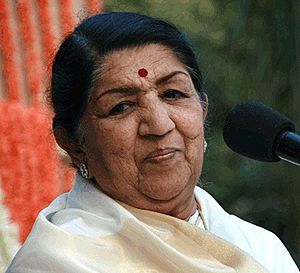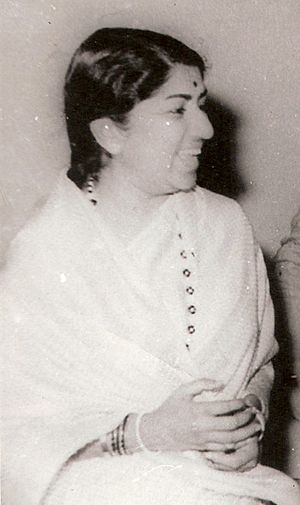Lata Mangeshkar facts for kids
Quick facts for kids
Lata Mangeshkar
|
|
|---|---|

Mangeshkar in 2008
|
|
| Born |
Hema Mangeshkar
28 September 1929 |
| Died | 6 February 2022 (aged 92) Mumbai, Maharashtra, India
|
| Other names | Queen of Melody Nightingale of India Voice of the Millennium |
| Occupation |
|
| Years active | 1942–2022 |
| Parent(s) |
|
| Relatives | Mangeshkar-Hardikar-Abhisheki family |
| Awards |
|
| Honours |
|
| Member of Parliament, Rajya Sabha | |
| Constituency | Nominated (Arts) |
| In office 22 November 1999 – 21 November 2005 |
|
| Musical career | |
| Genres | |
| Instruments | Vocals |
| Signature | |
 |
|
Lata Mangeshkar (born Hema Mangeshkar; 28 September 1929 – 6 February 2022) was an amazing Indian singer. She was known as a playback singer, meaning she sang songs for actors to lip-sync in movies. Many people think she was one of the greatest and most important singers in India's history.
Lata Mangeshkar sang for over 70 years! Because of her huge impact on Indian music, she earned special names like "Queen of Melody," "Nightingale of India," and "Voice of the Millennium." She recorded songs in more than 36 Indian languages, mainly Marathi, Hindi, and Bengali. She also sang in a few foreign languages, like English and Russian.
Throughout her career, she received many awards and honors. In 1989, she got the Dadasaheb Phalke Award from the Indian government. In 2001, she received the Bharat Ratna, which is India's highest award for civilians. She was only the second female singer to get this honor. France also gave her its highest civilian award in 2007.
In 1974, she was one of the first Indian playback singers to perform at the famous Royal Albert Hall in London. At one point, the Guinness World Records even listed her as the artist who had recorded the most songs in history!
Contents
Early Life and Family
Lata Mangeshkar was born on 28 September 1929, in Indore, India. She was the oldest child in her family. Her father, Deenanath Mangeshkar, was a classical singer and theatre actor. Her mother's name was Shudhamati.
Lata was first named "Hema" when she was born. But her parents later changed her name to Lata. This was after a character named Latika in one of her father's plays.
All of Lata's younger siblings also became famous singers and musicians. They are Meena Mangeshkar, Asha Bhosle, Usha Mangeshkar, and Hridaynath Mangeshkar. Lata learned her first music lessons from her father. When she was five, she started acting in her father's musical plays. She even left school on her first day because she wasn't allowed to bring her sister Asha with her!
Singing Career Milestones
Starting Out in the 1940s
In 1942, when Lata was just 13, her father passed away. A family friend, Master Vinayak, who owned a movie company, helped her. He encouraged her to start a career as a singer and actress.
She sang her first Marathi movie song in Kiti Hasaal (1942), but it was removed from the final film. Her first Hindi song was for the Marathi film Gajaabhaau (1943). At first, she had to focus on acting, which she didn't enjoy.
In 1945, she moved to Mumbai and began learning Hindustani classical music. After Master Vinayak died in 1948, music director Ghulam Haider became her mentor. He believed in her talent, even when others thought her voice was "too thin." Haider gave her a big break with the song "Dil Mera Toda" in the movie Majboor (1948). Lata later said he was her "Godfather."
She developed her own unique singing style. One of her biggest early hits was "Aayega Aanewaala" from the movie Mahal (1949). This song was so popular that it made Lata a star. It also helped other playback singers get the recognition they deserved. Before this, playback singers were often not even given credit for their work.
Success in the 1950s
In the 1950s, Lata Mangeshkar sang for many famous music directors. These included Naushad Ali, Shankar Jaikishan, and S. D. Burman. She sang many beautiful songs based on ragas (classical Indian melodies) for Naushad.
She won her first Filmfare Award for Best Female Playback Singer for the song "Aaja Re Pardesi" from the movie Madhumati (1958). A song she sang, "Aye Maalik Tere Bande Hum" from Do Aankhen Barah Haath (1957), was even adopted as a school anthem in Pakistan!
Iconic Songs of the 1960s
The 1960s brought more famous songs from Lata. These include "Pyar Kiya To Darna Kya" from Mughal-e-Azam (1960) and "Ajeeb Dastaan Hai Yeh" from Dil Apna Aur Preet Parai (1960).
A very special moment happened on 27 January 1963. After the Sino-Indian War, Lata sang the patriotic song "Aye Mere Watan Ke Logo" (meaning "Oh, People of My Country"). It is said that the Prime Minister of India, Jawaharlal Nehru, was moved to tears by her performance.
She continued to work with top music directors like Madan Mohan and Shankar–Jaikishan. The 1960s also marked the start of her long partnership with the music duo Laxmikant–Pyarelal. She sang over 700 songs for them, and many became huge hits.
Lata also sang many songs for Marathi and Bengali films during this time. She made her debut in Kannada films in 1967. For a short time, she had a disagreement with fellow singer Mohammed Rafi about royalty payments. But they later made up and continued to sing together.
Continuing Success in the 1970s
In the 1970s, Lata sang for many popular films. These included songs like "Chalte Chalte" from Pakeezah (1972). She continued to work with Laxmikant–Pyarelal and R. D. Burman.
She won her first National Film Award for Best Female Playback Singer in 1973 for "Beeti Na Bitai" from Parichay. She won another National Award in 1975.
Lata also started performing many concerts in India and other countries. Her first international concert was at the Royal Albert Hall in London in 1974. She helped change how Indian music concerts were seen in the West.
In 1978, she sang the main song for the film Satyam Shivam Sundaram. The film's director, Raj Kapoor, said the story was inspired by Lata. He imagined a woman with an ordinary look but a "golden voice" and wanted Lata to play the role.
The 1980s and Beyond
In the 1980s, Lata Mangeshkar worked with new music directors and continued to sing many hit songs. These included "Mere Naseeb Mein" from Naseeb (1980) and "Naino Mein Sapna" from Himmatwala (1983). She also sang "Dushman Na Kare" from Aakhir Kyon? (1985), which was later used in the Hollywood film Eternal Sunshine of the Spotless Mind.
In the 1990s, she sang for almost all the films by Yash Chopra and his company Yash Raj Films. Her songs from Dilwale Dulhania Le Jayenge (1995) were especially popular. These included "Tujhe Dekha To Yeh Jana Sanam" and "Mehndi Laga Ke Rakhna."
She also worked with famous composer A. R. Rahman on songs like "Jiya Jale" from Dil Se.. (1998) and "O Paalanhaare" from Lagaan (2001). In 1990, she even started her own film production company.
In 2019, Lata Mangeshkar released her last recorded song, "Saugandh Mujhe Is Mitti Ki." It was a tribute to the Indian army and the nation.
Other Work
Music Direction
Lata Mangeshkar also composed music for Marathi movies. She did this under the name Anand Ghan. She won an award for Best Music Director for the film Sadhi Manase (1965).
Film Production
She produced four films during her career:
- 1953 – Vaadal (Marathi)
- 1953 – Jhaanjhar (Hindi)
- 1955 – Kanchan Ganga (Hindi)
- 1990 – Lekin... (Hindi)
Awards and Honors
Lata Mangeshkar received many awards and honors throughout her life. The most important was the Bharat Ratna in 2001, India's highest civilian award.
Other major awards include:
- Padma Bhushan (1969)
- Dadasaheb Phalke Award (1989)
- Padma Vibhushan (1999)
- Officer of the French Legion of Honour (2007)
- Three National Film Awards for Best Female Playback Singer
- Four Filmfare Best Female Playback Awards
In 1969, she even gave up her Filmfare Award to encourage new singers. She later received the Filmfare Lifetime Achievement Award in 1993.
Two Indian states, Madhya Pradesh and Maharashtra, created the Lata Mangeshkar Award in her honor. Many famous musicians praised her voice, calling it a "miracle from God."
Passing Away
Lata Mangeshkar passed away on 6 February 2022, at the age of 92. She had been in the hospital for nearly a month due to COVID-19 and pneumonia.
The Indian government announced two days of national mourning to honor her. The national flag was flown at half-mast across India. Many important people, including the Prime Minister of India, Narendra Modi, and leaders from other countries, shared their sadness.
Her funeral was held with full state honors in Mumbai. Many famous people from the film and music industries, as well as politicians and fans, attended to pay their last respects. Her ashes were later immersed in the Godavari River.
Images for kids
-
Prime Minister Narendra Modi meets Asha Bhosle after paying tribute to Lata Mangeshkar in Mumbai.
See also
 In Spanish: Lata Mangeshkar para niños
In Spanish: Lata Mangeshkar para niños






